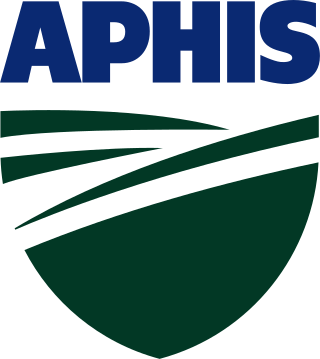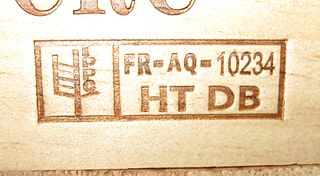Biosecurity refers to measures aimed at preventing the introduction and/or spread of harmful organisms to animals and plants in order to minimize the risk of transmission of infectious disease. In agriculture, these measures are aimed at protecting food crops and livestock from pests, invasive species, and other organisms not conducive to the welfare of the human population. The term includes biological threats to people, including those from pandemic diseases and bioterrorism. The definition has sometimes been broadened to embrace other concepts, and it is used for different purposes in different contexts.

The Animal and Plant Health Inspection Service (APHIS) is an agency of the United States Department of Agriculture (USDA) based in Riverdale, Maryland responsible for protecting animal health, animal welfare, and plant health. APHIS is the lead agency for collaboration with other agencies to protect U.S. agriculture from invasive pests and diseases. APHIS's PPQ is the National Plant Protection Organization for the U.S., and the agency's head of veterinary services/veterinary Deputy Administrator is the Chief Veterinary Officer of the United States.

The Codex Alimentarius is a collection of internationally recognized standards, codes of practice, guidelines, and other recommendations published by the Food and Agriculture Organization of the United Nations relating to food, food production, food labeling, and food safety.

International Standards For Phytosanitary Measures No. 15 is an International Phytosanitary Measure developed by the International Plant Protection Convention (IPPC) that directly addresses the need to treat wood materials of a thickness greater than 6mm, used to ship products between countries. Its main purpose is to prevent the international transport and spread of disease and insects that could negatively affect plants or ecosystems. ISPM 15 affects all wood packaging material and requires that they be debarked and then heat treated or fumigated with methyl bromide, and stamped or branded with a mark of compliance. This mark of compliance is colloquially known as the "wheat stamp". Products exempt from the ISPM 15 are made from an alternative material, like paper, plastic or wood panel products.

The European and Mediterranean Plant Protection Organization (EPPO) is an intergovernmental organisation responsible for European cooperation in plant protection in the European and Mediterranean region. Founded on April 18, 1951 and based in Paris, France, EPPO is the Regional Plant Protection Organization (RPPO) for Europe under the International Plant Protection Convention (IPPC).
The Agreement on the Application of Sanitary and Phytosanitary Measures, also known as the SPS Agreement or just SPS, is an international treaty of the World Trade Organization (WTO). It was negotiated during the Uruguay Round of the General Agreement on Tariffs and Trade (GATT), and entered into force with the establishment of the WTO at the beginning of 1995. Broadly, the sanitary and phytosanitary ("SPS") measures covered by the agreement are those aimed at the protection of human, animal or plant life or health from certain risks.
Phytosanitary may refer to:
Sanitary and phytosanitary (SPS) measures are measures to protect humans, animals, and plants from diseases, pests, or contaminants.

The North American Plant Protection Organization (NAPPO), is the phytosanitary standard setting organization recognized by the North American Free Trade Agreement (NAFTA). It was created in 1976 as a regional organization of the International Plant Protection Convention (IPPC) of the Food and Agriculture Organization (FAO) of the United Nations. Previously based in Ottawa, Ontario, it is now headquartered in Raleigh, North Carolina.
Euroseeds is a non-profit association for the seed industry in the European Union and the European Economic Area. An umbrella organization of national seed associations and individual seed companies, their members represent all aspects of the European seed industry including research, plant breeding, and the production and marketing of seeds of agricultural, horticultural and ornamental plant species. It was founded in November 2000 and was granted the legal status of international non-profit International Association (AISBL) according to Belgian law in April 2002. Its headquarters are located in Brussels, Belgium.
Animal and Plant Health Inspection Service (APHIS) and Plant Protection and Quarantine (PPQ) are responsible for safeguarding agriculture and natural resources from the risks associated with the entry, establishment, or spread of animal and plant pests and noxious weeds.
Plant Protection and Quarantine (PPQ) is one of six operational program units within the Animal and Plant Health Inspection Service (APHIS) of the United States Department of Agriculture (USDA). The PPQ works to safeguard agriculture and natural resources in the U.S. against the entry, establishment, and spread of animal and plant pests, and noxious weeds in order to help ensure the protection of native flora and an abundant, high-quality, and varied food supply.

Phytosanitary certification verifies phytosanitary worthiness. These certificates are used to attest that consignments meet phytosanitary import requirements and are undertaken by a National Plant Protection Organization (NPPO). Under the Agreement on the Application of Sanitary and Phytosanitary Measures and ISPM, a certificate for export or for re-export can be issued only by a public officer who is technically qualified and duly authorized by an NPPO.

The International Tropical Fruits Network (TFNet) is an independent and self-financing global network established under the auspices of the Food and Agriculture Organization of the United Nations (FAO). It is now an intergovernmental and inter-institutional international organization, with the mandate and role to promote sustainable global development of the tropical fruit in relation to production, consumption and trade. It is membership-based, with members acting through one lead agency on inter-country decisions.
Pest risk analysis (PRA) is a form of risk analysis conducted by regulatory plant health authorities to identify the appropriate phytosanitary measures required to protect plant resources against new or emerging pests and regulated pests of plants or plant products. Specifically pest risk analysis is a term used within the International Plant Protection Convention (IPPC) and is defined within the glossary of phytosanitary terms. as "the process of evaluating biological or other scientific and economic evidence to determine whether an organism is a pest, whether it should be regulated, and the strength of any phytosanitary measures to be taken against it". In a phytosanitary context, the term plant pest, or simply pest, refers to any species, strain or biotype of plant, animal or pathogenic agent injurious to plants or plant products and includes plant pathogenic bacteria, fungi, fungus-like organisms, viruses and virus like organisms, as well as insects, mites, nematodes and weeds.
Phytosanitary irradiation is a treatment that uses ionizing radiation on commodities, such as fruits and vegetables to inactivate pests, such as insects. This method is used for international food trade as a means to prevent spread of non-native organisms. It is used as an alternative to conventional techniques, which includes heat treatment, cold treatment, pesticide sprays, high pressure treatment, cleaning, waxing or chemical fumigation. It is often used on spices, grains, and non-food items. It inhibits the species reproduction cycle by destroying nuclear material primarily, whereas other methods are measured by species mortality. Each country has different effective approved dosages, although most follow guidelines established by the IPPC which has issued guidelines referred to as the International Standards for Phytosanitary Measures (ISPM). The most commonly used dose is 400 Gy based on USDA-APHIS guidelines.
Food Safety Agency of the Republic of Azerbaijan is a state institution under the responsibility of the Cabinet of Ministers of the Republic of Azerbaijan established to ensure regulation of food security. Goshgar Tahmazli was appointed to the post of the chairman of the agency by the presidential decree dated December 25, 2017.

Jan Carel Zadoks is a Dutch botanist and a professor emeritus of ecological plant pathology at Wageningen University & Research.
Walther Raúl Enkerlin Hoeflich is a Mexican entomologist, advocate, and pioneer researcher of the economics of applied sterile insect technique (SIT), currently based at the Joint Food and Agriculture Organization (FOA) and International Atomic Energy Agency (IAEA) Division.
The Plant Health Department is the phytosanitary agency of Saudi Arabia, a department of the Ministry of Environment, Water and Agriculture. PHD conducts inspections in the country, enforces quarantines, develops and proposes legislation, and produces plans, relevant to plant pests within the Kingdom. Externally, PHD is responsible for diplomacy related to plant health and international trade in agricultural inputs and products. International treaties and bodies include the IPPC, the WTO, and the Agreement on Technical Barriers to Trade.








